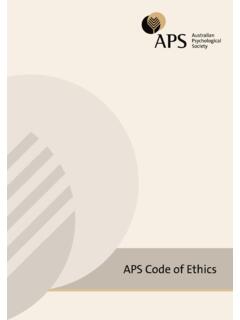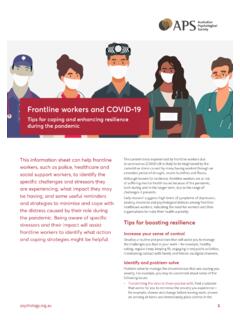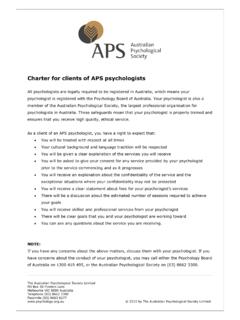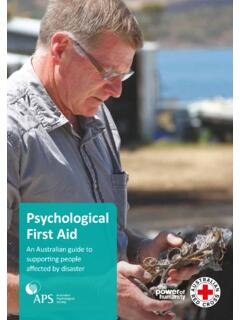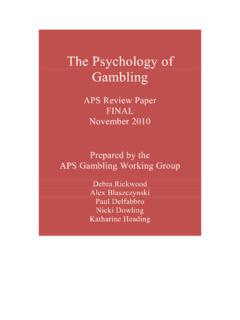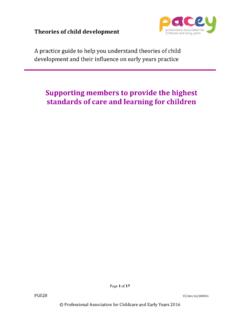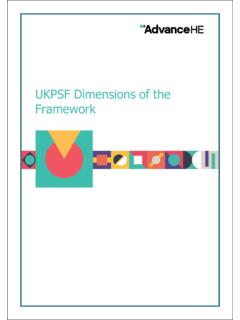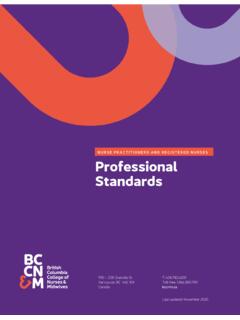Transcription of The framework for effective delivery of school psychology …
1 The framework for effective delivery of school psychology services: a practice guide for psychologists and school leaders APS Professional Practice September 2016. Table of Contents Executive 4. 5. Section 1: school psychology , a guide for school 7. school psychologist qualifications and 7. Professional indemnity 8. The skills of psychologists who work in 8. Section 2: Professional obligations in the 9. 9. Dual 9. Conflict of 9. Section 3: A model for effective Direct Indirect Whole school Section 4: Professional practice, a guide for psychologists in Ethical Informed consent: Informed consent: parent or Who has parent responsibility to provide consent?..14. How long does informed consent last?..15. Information Blanket Section 5: Ethical Limits to Access to school psychologist The two-part client Psychologist obligations versus school Who is the client?..20. Psychologists and multidisciplinary Dual service provision by Client access to Copyright 2016.
2 Section 6: Practice issues for psychologists in Psychologist session notes and record Ethical and legal obligations and record Guiding principles for report Assessment of school age Classroom observations and group Schools and Medicare items for psychological Transfer of student confidential Subpoenas and legal requests for student Legal requests for disclosure of test data and test Mandatory reporting Online psychological services and Cultural Working with Section 7: Requirements for effective professional practice in Definition of roles and responsibilities and the need for a school psychology Clarity regarding referral Adequate record keeping and file storage Access to peer consultation and professional Opportunities for professional Registration school psychologist-to-student Provision of Section 8: Appendix 1: Frequently asked Appendix 2: Complex dilemmas for psychologists providing service to Appendix 3: Complex dilemmas for psychologists providing assessments in Appendix 4: Continuing Professional Development for psychologists and school leaders.
3 43. Useful References ..45. 3. Executive summary This framework provides guidelines for the provision of effective psychological services in schools. It explains the basic principles and standards by which effective services can be delivered, and offers practical strategies for the delivery of psychological services to students in government and non-government education settings. It has been prepared by the Australian Psychological Society (APS) for use by psychologists, employers of psychologists and policy makers within government, Catholic and independent schools. The APS is the peak professional association for psychologists in Australia and a significant number of APS members are psychologists who work in school settings. Section 1 of the framework informs those working in education about the skills of psychologists who work in schools to address the barriers to learning and educational success for young people. It also informs school leadership and administrators about the role of psychologists who work in schools in promoting mental health and social competence for children and young people.
4 It provides information to both employers and practitioners about the effective delivery of school psychological service. effective school psychology service can only occur when it is fully supported and valued by the whole school community. The APS advocates common practice standards that should be met by all psychologists who work in schools. Adoption of such standards will promote a national and unified approach to the practice of psychology in Australian schools. Sections 1 to 7 of the framework present a model of psychological service delivery which is designed to encompass the many activities involved in the effective provision of psychological support to school populations. These sections offer a professional practice guide for psychologists regarding ethical obligations and common practice issues in schools. They are designed to be a model of best practice to guide and inform the development of school psychology documents in all school sectors in all states and territories.
5 It is recommended that this framework is read in conjunction with the APS Code of Ethics (2007) and other APS. resources (referenced in this document) related to the provision of psychological services to children and young people. It is also recommended that each education system or sector develops its own set of guidelines related to the provision of school psychological services in order to better reflect the unique requirements and ethos of local school populations. The APS encourages the use of this framework by its members as well as school leaders to both further the provision of psychological services in schools and enhance the already active psychology services in all school sectors. The framework for effective delivery of school psychology services: 4 a practice guide for psychologists and school leaders Introduction Psychologists who work in schools across Australia are identified by many different titles. These include educational psychologist, school psychologist, guidance officer and school counsellor.
6 Sometimes, the latter two titles are also used to identify individuals from other disciplines. However, within the psychology profession, psychologists who provide psychological services to schools are typically known simply as psychologists in schools. Psychologists in schools apply their psychological and educational expertise to support students to achieve academic success, psychological health, and social and emotional wellbeing. The primary purpose of the psychologist's work is to assist schools to address the barriers to learning for children and young people and to improve their educational achievement. Two significant barriers to educational achievement are mental health issues and learning difficulties. First, mental health problems affect a significant proportion of school -aged Australian children and young people and the needs of students influenced by these problems are complex and varied. Current statistics about the mental health of young Australians highlight the importance of a well-resourced and highly trained psychology workforce in schools to provide prevention, early intervention and intervention support for students who experience, or are at risk of, mental health problems and disengagement from school .
7 Disorders such as depression and anxiety (often associated with youth suicide), are the most prevalent mental health issues faced by young people in Australia today. The Australian government report on the second Australian Child and Adolescent Survey of Mental Health and Wellbeing, August 2015, summarises the following information on the mental health of young Australians aged 4-17 years: Almost one in seven ( per cent) 4-17 year-olds were assessed as having mental disorders in the previous 12 months. This is equivalent to 560,000 Australian children and adolescents. Males were more likely than females to have experienced mental disorders in the 12 months prior to the survey ( per cent compared with per cent). Attention Deficit Hyperactivity Disorder (ADHD) was the most common mental health disorder in children and adolescents ( per cent), followed by anxiety disorders ( per cent), major depressive disorder ( per cent). and conduct disorder ( per cent).
8 Based on these prevalence rates it is estimated that in the previous 12 months: - 298,000 Australian children and adolescents aged 4-17 years had ADHD. - 278,000 had anxiety disorders - 112,000 had major depressive disorder, and - 83,600 had conduct disorder. Almost one third ( per cent or per cent of all 4-17 year-olds) of children and adolescents with a mental health disorder had two or more mental health disorders at some time in the previous 12 months. Prevalence of mental health disorders did not differ significantly with age for males ( per cent for 4-11. year olds and per cent for 12-17 year-olds), but was slightly higher in older females than younger females ( per cent for 4-11 year-olds and per cent for 12-17 year-olds). One in six ( per cent) children and adolescents aged 4-17 years had used services for emotional or behavioural problems in the previous 12 months. Of this group: One in seven ( per cent) used health services One in nine ( per cent) used school services Just over half ( per cent) of 4-17 year-olds using services used both.
9 The Australian Child and Adolescent Survey of Mental Health and Wellbeing report showed that schools play a major role in supporting young people with emotional and behavioural problems and are often where symptoms of mental disorders are first identified. 5. Data for the per cent of 4-17 year-olds attending school or another educational institution showed that: A school staff member was among those to suggest that some help for emotional or behavioural problems was needed in two fifths ( per cent) of cases One in nine ( per cent) students had used a school service for emotional or behavioural problems in the previous 12 months. Of this group: - per cent received individual counselling, and - per cent received group counselling or participated in a support program Just over one fifth ( per cent) of young people who used health services had been referred by their school Teachers and other school staff provided per cent of students with informal support for emotional and behavioural problems.
10 This was higher ( per cent) for students assessed as having a mental disorder Of the four disorders affecting children and young people major depressive disorder had the greatest impact on school attendance. Students with this disorder averaged 20 days absent from school in the previous 12 months due to their symptoms. These mental health disorders adversely affect the emotional wellbeing, social functioning and academic achievement of children and young people. Consequently, there is a compelling need for specialised psychological intervention and support for children and adolescents in schools. The second major barrier to educational success at school is learning difficulty. In Australia it is likely that two to three children in each classroom will experience problems with learning. Psychologists who work in schools have expertise in education theory, cognitive assessment, educational assessment, developmental delay, the identification of specific learning disorders and teaching and learning styles.
